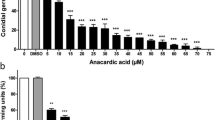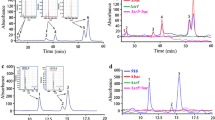Abstract
Fusarium graminearum, a devastating fungal pathogen, is the main pathogen of Fusarium head blight (FHB) in wheat globally; it results in significant yield loss and mycotoxin contamination that severely threatens global wheat production and food safety. However, despite ongoing efforts, controlling this pathogen still remains a major challenge. Surfactin, primarily synthesized by Bacillus sp. via non-ribosomal peptide synthetases, exhibits potent surfactant and antibacterial properties, but its antifungal mechanism has yet to be fully elucidated. We found that the EC50 of surfactin against hyphal growth of F. graminearum was 102.1 µg/mL, and control efficacy against wheat FHB under field conditions achieved 86.38% in wheat cultivar Huaimai 40 and 81.60% in wheat cultivar Zhoumai 36, indicating that surfactin has potential antifungal activity against F. graminearum. Accumulated intracellular ROS, decreased mitochondrial membrane potential (MMP), activated metacaspase activity and condensed chromatin, were induced by surfactin in F. graminearum hyphae, suggesting that growth inhibition of fungus is mainly caused by apoptosis-like cell death. Furthermore, accumulated intracellular ROS was evidenced to act as a key mediator of surfactin-induced apoptosis. Broad-spectrum caspase inhibitor Z-VAD-FMK treatment indicated that surfactin induces caspase-independent apoptosis in F. graminearum. Collectively, this study provides evidence that surfactin induces a ROS-mediated mitochondrial apoptosis in F. graminearum hyphae, and may exert its antifungal activity against F. graminearum by activating apoptosis. This study demonstrates the potential of surfactin as an antifungal agent for FHB biocontrol, provides a new perspective on the antifungal mechanism of surfactin against filamentous fungi, and contributes to the application of surfactin-producing microbes in the biocontrol of plant diseases.







Similar content being viewed by others
Data availability
The datasets generated during and/or analysed during this study are available from the corresponding author upon reasonable request.
References
Andrić S, Meyer T, Ongena M (2020) Bacillus responses to plant-associated fungal and bacterial communities. Front Microbiol 11:1350
Belloc F, Dumain P, Boisseau MR, Jalloustre C, Reiffers J, Bernard P, Lacombe F (1994) A flow cytometric method using Hoechst 33342 and propidium iodide for simultaneous cell cycle analysis and apoptosis determination in unfixed cells. Cytometry 17: 59-65
Bugeda A, Garrigues S, Gandia M, Manzanares P, Marcos JF, Coca M (2020) The antifungal protein afpb induces regulated cell death in its parental fungus Penicillium digitatum. Msphere 5:e00520–e00595
Cao XH, Wang AH, Wang CL, Mao DZ, Lu MF, Cui YQ, Jiao RZ (2010) Surfactin induces apoptosis in human breast cancer MCF-7 cells through a ROS/JNK-mediated mitochondrial/caspase pathway. Chem Biol Interact 183:357–362
Carrillo C, Teruel JA, Aranda FJ, Ortiz A (2003) Molecular mechanism of membrane permeabilization by the peptide antibiotic surfactin. Biochim Biophys Acta 1611:91–97
Chen L, Heng JY, Qin SY, Bian K (2018) A comprehensive understanding of the biocontrol potential of Bacillus velezensis LM2303 against Fusarium head blight. PLoS ONE 13:e0198560
Cheng J, Park TS, Chio LC, Fischl AS, Ye XS (2003) Induction of apoptosis by sphingoid long-chain bases in Aspergillus nidulans. Mol Cell Biol 23:163–177
Chowdhury SP et al (2015) Cyclic lipopeptides of Bacillus amyloliquefaciens subsp. plantarum colonizing the lettuce rhizosphere enhance plant defense responses toward the bottom rot pathogen Rhizoctonia solani. Mol Plant-Microbe Interact 28:984–995
Hu LB et al (2018) Thymol induces conidial apoptosis in Aspergillus flavus via stimulating k+ eruption. J Agric Food Chem 66:8530–8536
Hwang JH, Hwang IS, Liu QH, Woo ER, Lee DG (2012) (+)-Medioresinol leads to intracellular ROS accumulation and mitochondria-mediated apoptotic cell death in Candida albicans. Biochimie 94:1784–1793
Ito SI et al (2007) α-Tomatine, the major saponin in tomato, induces programmed cell death mediated by reactive oxygen species in the fungal pathogen Fusarium oxysporum. FEBS Lett 581:3217–3222
Krishnan N, Velramar B, Velu RK (2019) Investigation of antifungal activity of surfactin against mycotoxigenic phytopathogenic fungus fusarium moniliforme and its impact in seed germination and mycotoxicosis. Pestic Biochem Physiol 155:101–107
Kroemer G, Galluzzi L, Brenner C (2007) Mitochondrial membrane permeabilization in cell death. Physiol Rev 87:99–163
Kulkarni M, Stolp ZD, Hardwick JM (2019) Targeting intrinsic cell death pathways to control fungal pathogens. Biochem Pharmacol 162:71–78
Liu YN, Lu J, Sun J, Lu FX, Bie XM, Lu ZX (2019) Membrane disruption and DNA binding of Fusarium graminearum cell induced by C16-Fengycin A produced by Bacillus amyloliquefaciens. Food Control 102:206–213
Ma D, Wang G, Zhu J, Mu W, Dou D, Liu F (2022) Green leaf volatile trans-2-hexenal inhibits the growth of Fusarium graminearum by inducing membrane damage, ROS accumulation, and cell dysfunction. J Agric Food Chem 70:5646–5657
Marek SM, Wu J, Louise Glass N, Gilchrist DG, Bostock RM (2003) Nuclear DNA degradation during heterokaryon incompatibility in Neurospora crassa. Fungal Genet Biol 40:126–137
McMullen M, Bergstrom G, De Wolf E, Dill-Macky R, Hershman D, Shaner G, Van Sanford D (2012) A unified effort to fight an enemy of wheat and barley: Fusarium head blight. Plant Dis 96:1712–1728
Mousavi SA, Robson GD (2004) Oxidative and amphotericin B-mediated cell death in the opportunistic pathogen aspergillus fumigatus is associated with an apoptotic-like phenotype. Microbiology 150:1937–1945
Muzaffar S, Bose C, Banerji A, Nair BG, Chattoo BB (2016) Anacardic acid induces apoptosis-like cell death in the rice blast fungus Magnaporthe oryzae. Appl Microbiol Biotechnol 100:323–335
Ntushelo K, Ledwaba LK, Rauwane ME, Adebo OA, Njobeh PB (2019) The mode of action of Bacillus species against Fusarium graminearum, tools for investigation, and future prospects. Toxins 11:606
Ongena M, Jacques P (2008) Bacillus lipopeptides: versatile weapons for plant disease biocontrol. Trends Microbiol 16:115–125
Pang L et al (2021) Improvement of antifungal activity of a culture filtrate of endophytic Bacillus amyloliquefaciens isolated from kiwifruit and its effect on postharvest quality of kiwifruit. J Food Biochem 45:e13551
Pei P, Xiong K, Wang X, Sun B, Zhao Z, Zhang X, Yu J (2022) Predictive growth kinetic parameters and modelled probabilities of deoxynivalenol production by Fusarium graminearum on wheat during simulated storing conditions. J Appl Microbiol 133:349–361
Raaijmakers JM, Mazzola M (2012) Diversity and natural functions of antibiotics produced by beneficial and plant pathogenic bacteria. Annu Rev Phytopathol 50:403–424
Ramsdale M (2008) Programmed cell death in pathogenic fungi. Biochim Biophys Acta 1783:1369–1380
Robson GD (2006) Programmed cell death in the aspergilli and other filamentous fungi. Med Mycol 44:109–114
Roze LV, Linz JE (1998) Lovastatin triggers an apoptosis-like cell death process in the fungus Mucor racemosus. Fungal Genet Biol 25:119–133
Sarwar A et al (2018) Biocontrol activity of surfactin A purified from Bacillus NH-100 and NH-217 against rice bakanae disease. Microbiol Res 209:1–13
Schoenborn AA, Yannarell SM, Wallace ED, Clapper H, Weinstein IC, Shank EA (2021) Defining the expression, production, and signaling roles of specialized metabolites during Bacillus subtilis differentiation. J Bacteriol 203:e0033721
Semighini CP, Harris SD (2010) Methods to detect apoptotic-like cell death in filamentous fungi. Methods Mol Biol 638:269–279
Sharon A, Finkelstein A, Shlezinger N, Hatam I (2009) Fungal apoptosis: function, genes and gene function. FEMS Microbiol Rev 33:833–854
Shlezinger N, Goldfinger N, Sharon A (2012) Apoptotic-like programed cell death in fungi: the benefits in filamentous species. Front Oncol 2:97
Sikhakolli UR, López-Giráldez F, Li N, Common R, Townsend JP, Trail F (2012) Transcriptome analyses during fruiting body formation in Fusarium graminearum and Fusarium verticillioides reflect species life history and ecology. Fungal Genet Biol 49:663–673
Snook ME, Mitchell T, Hinton DM, Bacon CW (2009) Isolation and characterization of leu7-surfactin from the endophytic bacterium Bacillus mojavensis RRC 101, a biocontrol agent for Fusarium verticillioides. J Agric Food Chem 57:4287–4292
Tian J, Wang Y, Lu Z, Sun C, Zhang M, Zhu A, Peng X (2016) Perillaldehyde, a promising antifungal agent used in food preservation, triggers apoptosis through a metacaspase-dependent pathway in Aspergillus flavus. J Agric Food Chem 64:7404–7413
Uren AG, O’Rourke K, Aravind LA, Pisabarro MT, Seshagiri S, Koonin EV, Dixit VM (2000) Identification of paracaspases and metacaspases: two ancient families of caspase-like proteins, one of which plays a key role in MALT lymphoma. Mol Cell 6:961–967
Vo TTT, Liu JF, Wu CZ, Lin WN, Chen YL, Lee IT (2020) Surfactin from Bacillus subtilis induces apoptosis in human oral squamous cell carcinoma through ROS-regulated mitochondrial pathway. J Cancer 11:7253–7263
Wachowska U, Sulyok M, Wiwart M, Suchowilska E, Kandler W, Krska R (2022) The application of antagonistic yeasts and bacteria: an assessment of in vivo and under field conditions pattern of Fusarium mycotoxins in winter wheat grain. Food Control 138:109039
Wang X, Wang Y, Zhou Y, Wei X (2014) Farnesol induces apoptosis-like cell death in the pathogenic fungus Aspergillus flavus. Mycologia 106:881–888
Wei CL, Zhang F, Song LL, Chen XF, Meng XH (2021) Photosensitization effect of curcumin for controlling plant pathogen Botrytis cinerea in postharvest apple. Food Control 123:107683
Wu YS, Ngai S, Goh BH, Chan KG, Lee LH, Chuah LH (2017) Anticancer activities of surfactin and potential application of nanotechnology assisted surfactin delivery. Front Pharmacol 8:761
Yaakoub H, Mina S, Calenda A, Bouchara JP, Papon N (2022) Oxidative stress response pathways in fungi. Cell Mol Life Sci 79:333
Yim G, Wang HH, Davies J (2007) Antibiotics as signalling molecules. Philos Trans R Soc Lond B Biol Sci 362:1195–1200
Acknowledgements
This work was supported by National natural science foundation of China (32172280), Natural science foundation of Henan province (182300410042) and the earmarked fund for CARS-13.
Funding
This study was funded by National natural science foundation project of China (32172280), Natural science foundation of Henan province (182300410042) and the earmarked fund for CARS-13.
Author information
Authors and Affiliations
Contributions
CL: Investigation, Conceptualization, Data curation, Formal analysis, Methodology, Writing-original draft, Writing-review & editing, Supervision. XX: Data curation, Formal analysis, Methodology, Writing-original draft, Writing-review & editing. SY: Data curation, Formal analysis, Methodology. XQ: Data curation, Formal analysis, Methodology. LY: Investigation, Formal analysis, Methodology. HY: Resources, Supervision, Project administration. BK: Conceptualization, Resources, Supervision, Project administration.
Corresponding author
Ethics declarations
Conflict of interest
The authors declare no conflict of interest.
Additional information
Publisher’s Note
Springer Nature remains neutral with regard to jurisdictional claims in published maps and institutional affiliations.
Supplementary Information
Below is the link to the electronic supplementary material.
Rights and permissions
Springer Nature or its licensor (e.g. a society or other partner) holds exclusive rights to this article under a publishing agreement with the author(s) or other rightsholder(s); author self-archiving of the accepted manuscript version of this article is solely governed by the terms of such publishing agreement and applicable law.
About this article
Cite this article
Liang, C., Xi-xi, X., Yun-xiang, S. et al. Surfactin inhibits Fusarium graminearum by accumulating intracellular ROS and inducing apoptosis mechanisms. World J Microbiol Biotechnol 39, 340 (2023). https://doi.org/10.1007/s11274-023-03790-2
Received:
Accepted:
Published:
DOI: https://doi.org/10.1007/s11274-023-03790-2




